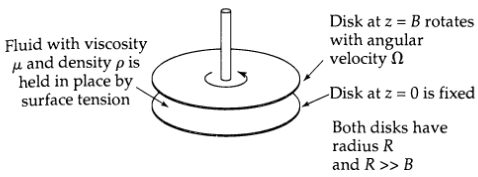Parallel-disk viscometer (Fig. 3B.5), a fluid, whose viscosity is to be measured, is placed in the gap
Question:
Parallel-disk viscometer (Fig. 3B.5), a fluid, whose viscosity is to be measured, is placed in the gap of thickness B between the two disks of radius R. One measures the torque Tz required to turn the upper disk at an angular velocity Ω. Develop the formula for deducing the viscosity from these measurements. Assume creeping flow.
(a) Postulate that for small values of Ω the velocity profiles have the form v1 = 0, vz = 0, and vθ = rf (z); why does this form for the tangential velocity seem reasonable? Postulate further that P = P(r, z). Write down the resulting simplified equations of continuity and motion.
(b) From the O-component of the equation of motion, obtain a differential equation for f(z). Solve the equation for f(z) and evaluate the constants of integration. This leads ultimately to the result vθ = Ω r(z/B). Could you have guessed this result?
(c) Show that the desired working equation for deducing the viscosity is μ = 2BTz/πΩR4.
(d) Discuss the advantages and disadvantages of this instrument.

Step by Step Answer:






